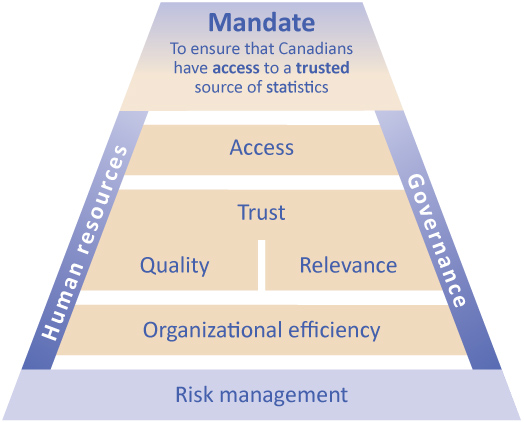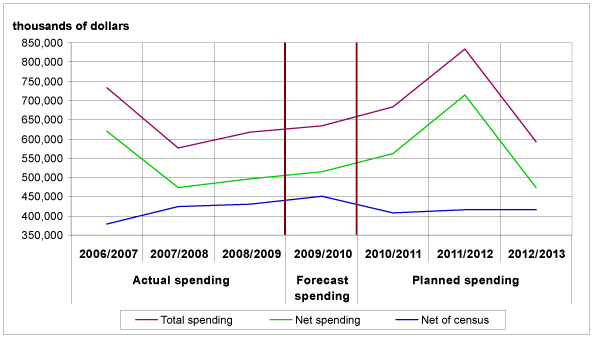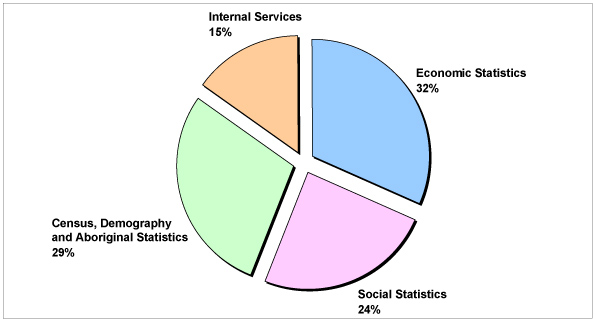Common menu bar links
Breadcrumb Trail
ARCHIVED - Statistics Canada
 This page has been archived.
This page has been archived.
Archived Content
Information identified as archived on the Web is for reference, research or recordkeeping purposes. It has not been altered or updated after the date of archiving. Web pages that are archived on the Web are not subject to the Government of Canada Web Standards. As per the Communications Policy of the Government of Canada, you can request alternate formats on the "Contact Us" page.
Minister's message

Our government is committed to positioning Canada to exit the current downturn quickly and emerge stronger and more competitive in the global economy. In doing so, Industry Canada and its Portfolio partners will continue to play their key roles in increasing the country's capacity to create jobs and economic growth—for next year and the next decade.
While the recession originated beyond our borders, it had real consequences for Canadians and Canadian business. And despite improving conditions, there is work to be done. In 2010, a major focus will be completing the stimulus measures of Canada's Economic Action Plan (www.actionplan.gc.ca). Introduced in Budget 2009, the Plan's full effect will be felt in 2010/2011, and its measures will help solidify the recovery.
Over this period, Industry Canada and its Portfolio partners will work with industries and sectors hit hardest by the recession. Initiatives will include activities to boost community economic development and to extend broadband infrastructure to underserved or unserved areas across the country. To build on the momentum gained through our past investments in science and technology, significant effort will be directed to shaping the knowledge-based economy.
Industry Canada will also focus on supporting business and industry to capitalize on emerging opportunities at home and abroad. Getting our economic frameworks right, through forward-looking policies, is central to ensuring Canada's place in the global marketplace. We remain committed to two-way trade and investment, which raises our capacity to create jobs and economic growth and provides for sustainable prosperity.
In order to support decision making by Canadians and their elected representatives, Statistics Canada is committed to providing access to a trusted source of information. The main priorities for 2010/2011 are to ensure that our information is more easily accessible, our 2011 Census preparations are complete, our economic and social statistics remain strong in relevance and quality, and our operations become more efficient.
I will work with my colleagues, the private sector and other governments to advance the recovery and build the foundation for a strong, competitive economy.
It is my pleasure to present this year's Report on Plans and Priorities for Statistics Canada.
The original version was signed by
Tony Clement
Minister of Industry
Chief Statistician's message
I am pleased to present Statistics Canada's Report on Plans and Priorities.
As Chief Statistician of Canada, my goal is to ensure that Canadians continue to have access to a trusted source of statistics about Canada. Relevant, high-quality statistics are important to our society. They are a key component in the effective governance of the country.
Relevant statistics are those that are consistent with what Canadians most need. Without appropriate and timely action, relevance of data declines as Canadians' needs change with the evolution of the country. Business births, deaths, mergers and acquisitions change the face of our economy. Our society and communities evolve through mobility, immigration and education. Some issues, such as those related to the environment, are increasingly front of mind for Canadians and their institutions, whereas other issues become less relevant.
Similarly, without appropriate and timely action, quality also declines over time as many everyday changes affect the collection of data. For example, it is ever more difficult to conduct surveys because of the increasing use of cell phones and the number of households that are frequently absent from their homes. On the other hand, the Internet provides a new opportunity for connecting with Canadians.
Statistics Canada must continuously adjust the way it does business to keep up with these changes, and to protect the relevance and quality of the nation's statistics.
Statistics Canada's main priorities for 2010 include the following:
- prepare to conduct the 2011 Census of Population and the 2011 Census of Agriculture
- produce new quantity and price indicators for the increasingly important service sector
- improve the availability of data for the Aboriginal population
- develop a framework to guide and prioritize the collection of high-quality environment statistics
- improve Canadians' access to economic and social data.
I invite readers to learn more about these and other initiatives in this report on Statistics Canada's plans and priorities. I also invite readers to benefit from the work of their national statistical agency by monitoring the results of our programs and analyses on our website (www.statcan.gc.ca).
The original version was signed by
Munir A. Sheikh
Chief Statistician of Canada
1 Agency overview
1.1 Raison d'être and responsibilities
The Government of Canada established Statistics Canada to ensure that Canadians have access to a trusted source of statistics on Canada. Access to trusted information is fundamental in an open, democratic society to support decision making by citizens and their elected representatives. A large portion of Statistics Canada's activities is devoted to meeting the needs of federal, provincial and territorial government policy departments and providing ongoing measurement of Canadian socioeconomic dynamics and emerging trends.
Statistics Canada's mandate derives primarily from the Statistics Act. The Act requires that the agency collect, compile, analyse and publish statistical information on the economic, social and general conditions of the country and its people. This mandate covers a broad range of statutory requirements, as well as contractual obligations.
The Statistics Act requires Statistics Canada to conduct a Census of Population and a Census of Agriculture every fifth year. The Act also confers substantial powers on the agency to collect information for statistical purposes through surveys of businesses and households.
Statistics Canada is also mandated to provide co-ordination and leadership for the national statistical system, specifically to avoid duplication in the information collected by government. The agency can, by law, access administrative records (e.g., tax data, customs declarations, and birth and death records), enabling it to reduce reporting burden on business and individual respondents. Statistics Canada is considered a leader among statistical agencies around the world in reducing reporting burden through the use of administrative data, partnerships and cost-recovery arrangements with other organizations.
1.2 Statistics Canada's business model
Strategic outcome1
Canadians have access to timely, relevant and quality statistical information on Canada's changing economy and society for informed debate, research and decision making on social and economic issues.
Statistics Canada's performance management framework focuses on the components of the strategic outcome as well as on the enablers that make the achievement of that outcome possible.
In the business model, the strategic outcome described above is achieved by providing access to a trusted source of information. Trust can be established only if data are relevant, meaning they meet the most important needs of users, and if users are confident that the information is of the highest possible quality. Access, relevance and quality can be optimized only if the agency practises maximum organizational efficiency.
The enablers that allow these outcomes to be achieved include the agency's human resources, governance framework and risk management strategy.
Chart 1 Performance management framework

The following paragraphs provide brief descriptions of the components of this framework.
Components of the strategic outcome
- Access—Statistics Canada has a rich inventory of information holdings. Access refers to awareness
and use of this information. Providing access to users has two aspects: access to publicly available data; and access,
for statistical and research use, to microdata files, in a manner that fully preserves the confidentiality of individual
households and businesses. The agency's principal strategy for providing access to publicly available statistics is
through its Internet website. Providing access to more detailed microdata is achieved by facilitating controlled use
of these data in a national network of Research Data Centres.
- Relevance—Relevance is defined as the production of information that responds to Canada's evolving
and highest-priority needs. Relevance or usefulness of data is largely in the hands of the users. To understand their
needs, Statistics Canada monitors data usage and consults with users, stakeholders and advisory committees to ensure
that its products and services are meeting the most important information needs of the present and the future. A reality
of the world of statistics is that relevance of the data produced by any statistical agency diminishes over time, as
the needs of the citizens and their government change with the evolution of the country. A statistical agency must evolve
continuously to stay relevant. Statistics Canada has developed a variety of tools to monitor the changing needs of the
country.
- Quality—Users must be able to trust that the agency's statistics are factual and reliable representations
of the social and economic worlds they are meant to describe. Like relevance, the quality of data produced by any statistical
agency diminishes over time automatically unless steps are taken proactively to deal with this trend. The approach used
by Statistics Canada to maintain and improve data quality comprises a variety of measures that are acting jointly at
various levels throughout the organization. Such measures include a strong program of research and innovation in statistical
methods, the regular updating of standard classifications and an ongoing program of internal quality reviews to identify
and eliminate any specific weaknesses, and to share and promote best practices across the agency.
- Organizational efficiency—Statistics Canada has a long tradition of producing the largest possible volume of high-quality information with the resources available to it. It has in place a business model, a unique governance and management structure, and a dynamic system to innovate, manage risks and anticipate and solve problems as they emerge.
Enablers
- Human resources—People are by far Statistics Canada's most important asset. Therefore, effective
human resource management is a key factor in achieving the agency's strategic outcome. Given the specialized skill set
of a statistical agency, effort is focused on recruitment, training, career advancement and maintaining a positive workplace.
Statistics Canada fully embraces the Public Service Renewal initiatives in its human resource management practices.
- Governance—Statistics Canada has a mature and effective governance and management structure, which
integrates strategic priority setting and decision making and ensures accountability.
A well-established system of corporate-level committees is responsible for consultation and recommending strategic options for program development and delivery. Committee membership includes senior managers from across Statistics Canada. Leadership is provided by Policy Committee, which is responsible for strategic direction and for corporate-level management and decisions. All significant corporate issues are reviewed at this highest level, with final decisions rendered by the Chief Statistician as Chair of Policy Committee.
The decision-making infrastructure ensures that decisions are based on what is best for the organization; it encourages innovation and strategies to improve efficiency; and it increases capacity by enabling the effective integration of issues and initiatives.
- Risk management—In keeping with government-wide expectations of good governance and modern comptrollership,
Statistics Canada places great emphasis on managing risks in all planning and delivery activities.
The agency currently has in place an effective, integrated risk management strategy whose development and implementation have been guided, over the years, by Treasury Board Secretariat requirements. With respect to 'risk,' Statistics Canada has a framework to identify risks in each area of its work and has also developed risk profiles. With respect to 'management,' it has set up a number of processes. Combining both 'risk' and 'management,' these processes include a comprehensive system of biennial and quadrennial program reviews covering all sources of risk. They also include a detailed quality review of selected programs every year, focusing on risks affecting data accuracy. The results from these reviews are brought together into the annual corporate long-term planning process, where they are analysed and where decisions are made to ensure that Statistics Canada addresses all important risks. Ultimately, all major risk management issues are brought to Policy Committee for discussion and final decision.
1.3 Strategic outcome and program activity architecture
Statistics Canada allocates resources entrusted to it in accordance with its program activity architecture. This framework of program activities and subactivities, established by Statistics Canada in consultation with the Treasury Board Secretariat, reflects the Government of Canada standards for transparent and accountable reporting. Statistics Canada's activities are divided into three main program activities, based on subject matter: Economic Statistics; Social Statistics; and Census, Demography and Aboriginal Statistics. A fourth program activity covers Internal Services.
Within these groupings are the subactivities, which correspond to branches in Statistics Canada's organizational structure. Within the subactivities is a third level of sub-subactivities, which correspond to the agency's divisions.
Chart 2 Components of the program activity architecture

1.4 Planning summary
Financial and human resources
Statistics Canada's statistical program is funded from two sources: direct parliamentary appropriations and cost-recovery activities. In recent years, the agency's 'respendable' cost-recovery revenues—revenues it is authorized to spend on the activity that generated them—have added more than $100 million to its total resources. A large portion of these respendable revenues is from federal departments to fund specific statistical projects. Statistics Canada assumes that cost-recovery revenues will remain in the same vicinity each year for the foreseeable future.
The total planned spending and total planned human resources for the next three fiscal years are summarized in the following table. This table shows the year-to-year variability in Statistics Canada's resources, the result of the cyclical activity supporting the Census of Population and the Census of Agriculture. Funding typically peaks in the fiscal year in which the censuses are conducted.
| 2010/2011 | 2011/2012 | 2012/2013 | |
|---|---|---|---|
| Planned spending (thousands of dollars) | 562,733 | 713,951 | 473,469 |
| Human resources (full-time equivalents) | 6,115 | 6,489 | 5,795 |
| Notes: Planned spending amounts are presented net of respendable revenue. Totals may differ between tables because of rounding. |
|||
Planned spending and expected results
Total planned spending and expected results for each program activity, for each of the next three fiscal years, are detailed below.
| Program activity | Expected results | Forecast spending | Planned spending | Alignment to Government of Canada outcomes | ||
|---|---|---|---|---|---|---|
| 2009/2010 | 2010/2011 | 2011/2012 | 2012/2013 | |||
| thousands of dollars | ||||||
| Economic Statistics | Statistics produced by Statistics Canada are available through
a wide range of easily accessible media formats and venues. Canadians are aware of the availability of these statistics and of their high quality, and of the professionalism and non- partisanship of Statistics Canada. |
190,068 | 201,916 | 207,349 | 207,353 | Statistics Canada program activities are linked to the Government Affairs outcome area. |
| Social Statistics | 192,457 | 188,311 | 191,286 | 191,272 | ||
| Census, Demography and Aboriginal Statistics | 108,108 | 191,914 | 334,816 | 94,342 | ||
| Internal Services | ... | 83,758 | 100,592 | 100,500 | 100,502 | ... |
| Budgetary Main Estimates (gross) | ... | 574,391 | 682,733 | 833,951 | 593,469 | ... |
| Less: Respendable revenue | ... | 120,000 | 120,000 | 120,000 | 120,000 | ... |
| Total Main Estimates | ... | 454,391 | 562,733 | 713,951 | 473,469 | ... |
| Adjustments1 | ... | 59,619 | 0 | 0 | 0 | ... |
| Total planned spending | ... | 514,010 | 562,733 | 713,951 | 473,469 | ... |
| Note: Totals may differ between tables
because of rounding. 1. Adjustments are to accommodate approvals obtained since the release of the Main Estimates. Adjustments include budget initiatives, Supplementary Estimates, etc. … not applicable |
||||||
1.5 Contribution of priorities to the strategic outcome
The table below provides a summary of Statistics Canada's operational and enabling priorities. Detailed information on these priorities and their timelines is presented in section 2.
| Contribution to strategic outcome | ||||
|---|---|---|---|---|
| Access | Relevance | Quality | Organizational efficiency | |
| Operational priorities | ||||
| Economic Statistics | ||||
| Improve access to economic data | X | |||
| Deliver gross domestic product data | X | |||
| Develop a framework for environment statistics | X | |||
| Deliver Consumer Price Index data and better reflect current consumer spending patterns | X | X | ||
| Reflect changes to Canadian accounting standards in survey programs | X | |||
| Produce new quarterly services indicators and improve coverage of service price indexes | X | X | ||
| Social Statistics | ||||
| Improve access to social data | X | |||
| Respond to information needs on the impact of the H1N1 pandemic | X | |||
| Deliver Labour Force Survey data | X | |||
| Begin to implement electronic data reporting for household surveys | X | X | ||
| Census, Demography and Aboriginal Statistics | ||||
| Enhance the Aboriginal Statistics Program | X | |||
| Prepare to conduct the 2011 Census of Population | X | X | X | |
| Prepare to conduct the 2011 Census of Agriculture | X | X | X | |
| For future agricultural censuses, study the feasibility of using income tax data to replace the collection of financial data | X | |||
| Internal Services | ||||
| Provide a more user-friendly website | X | |||
| Increase stakeholder engagement for improved relevance of Statistics Canada's programs | X | |||
| Enabling priorities | ||||
| Internal Services | ||||
| Implement the new human resource management action plan | X | X | X | X |
| Consolidate governance of informatics technology services | X | X | X | X |
| Enhance and document the integrated risk management strategy | X | X | X | X |
| Strengthen the internal audit function | X | X | X | X |
| Note: X represents an operational or enabling priority matched with a contribution to the strategic outcome. | ||||
Indicators and targets for the strategic outcome
Measuring the extent to which Statistics Canada is able to achieve its strategic outcome is very important. The table below presents the main indicators that the agency is planning to use to assess its performance, along with the target it has established for each one.
| Indicators | Targets/Benchmarks |
|---|---|
| Indicators of access | |
| Number of visits to the Statistics Canada website | Annual increase exceeds 5%, which is five times the annual population growth rate |
| Number of page views of electronic publications | Annual increase exceeds 5%, which is five times the annual population growth rate |
| Client satisfaction with price to access data | Rating of 4 on a scale of 5 |
| Indicators of relevance | |
| Number of data series downloaded from the online database (CANSIM) | Annual increase exceeds 5%, which is five times the annual population growth rate |
| Clients' satisfaction with Statistics Canada's ability to meet their needs | Rating of 4 on a scale of 5 |
| Number of references in Federal Budgets | Several |
| Indicators of quality | |
| Percentage of major statistical outputs whose sampling accuracy is within set objectives | 95% |
| Net undercoverage for 2011 Census of Population | Less than 3% |
| Response rates for 2011 Census of Population | 98% or more |
| Indicators of organizational efficiency | |
| Rating on 21 areas of management, as defined in the federal Management Accountability Framework | Rank among the best of other departments of similar size |
| Number of business surveys using taxation/administrative data | Continual increase |
| Index of response burden hours (1991=100) | 60 or less |
| International comparability | Rank among the best in comparison with other G7 countries |
| Cost per dwelling for 2011 Census of Population | Less than $42 |
| Notes: Client satisfaction data are derived from client satisfaction surveys. These surveys use measures that are consistent with the common measurement tool in use across the federal government. Data series downloaded from the online database are those that are downloaded by external users from Statistics Canada's online database (CANSIM). Major statistical outputs whose sampling accuracy is within set objectives: Most surveys are based on statistical sampling. Estimates based on sampling can be expected to vary from sample to sample, and to differ from those that would result from a complete census. Sampling accuracy objectives are set on a survey-by-survey basis. Net census undercoverage is the number of people missed less the number of people counted more than once. Use of tax and administrative data refers to the use by Statistics Canada of data from the Canada Revenue Agency and other administrative sources as an alternative to obtaining data directly from respondents. This reduces the number of questionnaires going to respondents as well as the associated response burden. |
|
1.6 Expenditure profile
Chart 3 Expenditure profile, 2006/2007 to 2012/2013

Notes:
Total spending includes respendable cost-recovery revenues.
Net spending is total spending less expenditures related to cost-recovery programs.
Net of census is total spending less expenditures related to cost-recovery programs less direct spending on the Census Program.
As shown above, total and net spending will increase in 2010/2011, peak in 2011/2012 when the 2011 Census of Population and 2011 Census of Agriculture will be conducted, and drop sharply in 2012/2013 as these activities begin to wind down. This pattern is typical for the agency because of the cyclicality of the Census Program, as demonstrated by the decrease in spending from 2006/2007 to 2007/2008.
The line showing net of census demonstrates the relative stability of the agency's spending when census and cost recovery are removed.
The chart below shows the distribution of net funding by program activity. Economic Statistics and Social Statistics are responsible for 32% and 24%, respectively. Census, Demography and Aboriginal Statistics will consume 29% of the spending, reflecting the increase in census activities for this year.
Chart 4 Allocation of funding, by program activity, 2010/2011

1.7 Voted and statutory items
The table below shows the way Parliament has approved Statistics Canada resources, the changes in the resources derived from Supplementary Estimates and other authorities, and what funds were spent on.
| Vote number or statutory item | Truncated vote or statutory wording | Main Estimates1 | |
|---|---|---|---|
| 2009/2010 | 2010/2011 | ||
| thousands of dollars | |||
| 95 | Operating expenditures | 391,910 | 491,001 |
| Statutory | Contributions to employee benefit plans | 62,481 | 71,732 |
| Total | 454,391 | 562,733 | |
| Note: Totals may differ between tables because
of rounding. 1. Amounts of Main Estimates are presented net of respendable revenue. |
|||
